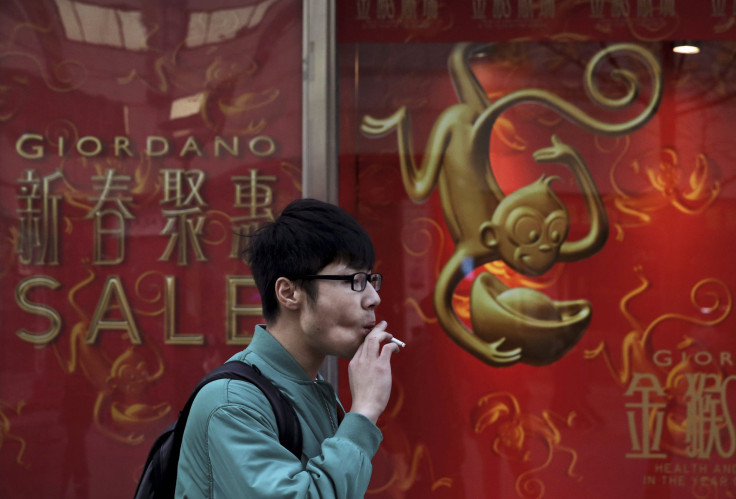Gory Warnings On Cigarette Packets ‘Not Consistent With Chinese Cultural Values,’ China’s Tobacco Regulator Says

SHANGHAI — Signs by Chinese roadsides carry pictures of car wrecks as warnings to drivers, official media regularly show graphic scenes of the bloody aftermath of accidents and crimes — but China’s national tobacco administrator says gory images of the damage to health caused by smoking on cigarette packaging would be inappropriate as they are “not consistent with Chinese cultural values.”
Duan Tieli, deputy head of industry regulator the State Tobacco Monopoly Administration (STMA), told reporters at China’s legislative session this week that the country had no plans to add graphic pictures of skulls, blackened lungs or teeth to cigarette packaging, as is now required in a number of other countries — though it has faced strong opposition from the tobacco industry in the U.S. Duan explained that such images did “not conform with Chinese culture,” the official Global Times reported. But activists said the comments highlighted the authorities’ ambivalent attitude to tackling rampant smoking, with some observers noting that other types of graphic image are widely available in China.
China has at least an estimated 320 million smokers — including more than half of all Chinese men — and 740 million passive smokers, according to the World Health Organization, which says smoking-related illnesses kill 3,000 people a day, or almost 1.1 million a year, in the nation. (A study published by the British Medical Journal two years ago said this figure which could reach 1.5 million a year by 2040.) In recent years, under growing pressure from medical experts, the Chinese government has taken some steps to combat smoking: it has banned tobacco advertising in media and public places, as well as sports sponsorship by tobacco firms, while the capital Beijing last year introduced the nation’s strictest smoking rules, banning lighting up in all indoor public places, and some outdoor ones too. President Xi Jinping’s wife Peng Liyuan has also taken on a role as an anti-smoking ambassador.
However, the tobacco industry is a major employer in China — which produces some 40 percent of the world’s cigarettes — and contributes an estimated 7 percent of China’s total tax revenue (and as much as 45 percent of tax in Yunnan, one of the country's main tobacco-producing provinces.) And with the vast majority of cigarettes produced by state-owned China National Tobacco Corp., the chance of extreme action — like in Australia where packets show dying lung cancer sufferers, or Brazil, where they warn men that smoking causes impotence, still seems unlikely.
Some Chinese cigarette packets carry a two-line warning saying "smoking is harmful to health, giving up smoking is good for your health" — but some packets carry no health warning at all, and Chinese cigarette packaging is generally dominated by pleasant images. The ThinkTank Research Center for Health Development, a Beijing-based NGO, recently accused the STMA — which is closely linked to China National Tobacco Corp. — of obstructing the use of graphic warning labels for fear that this would hit sales. The group said this was one reason why China has struggled to effectively reduce the number of smokers — the total figure rose by 15 million over the past five years, according to official statistics.
The NGO’s deputy director Wu Yiqun told the Global Times that cigarette packets should at least carry warnings that smoking “will cause diseases such as lung cancer.” Wu also noted that only 18 Chinese cities — with just ten percent of the country’s population — currently have restrictions on smoking.
China last year did increase wholesale tax on cigarettes from five percent to 11 percent, leading to a 6.3 percent rise in tobacco prices, according to the STMA. It said this had led to a fall in sales of 2.4 percent last year, with production also down, by 0.9 percent, and “value-added from the tobacco sector down 15.6 percent from a year earlier” in January-February. Bloomberg reported that this had shaved 0.7 percentage points off China’s overall industrial output, which rose just 5.4 percent in Jan-Feb from a year earlier, its slowest rate since 2009.
Yet China National Tobacco Corp's tax payments still rose to more than 600 billion yuan ($92.37 billion) last year, according to Bloomberg. And STMA’s Duan said there were no further plans to raise prices further, saying this was “not the only way to control tobacco use.”
Plans to introduce a national tobacco control law, meanwhile, do not appear to have made any significant progress. A draft announced in late 2014 was welcomed by the World Health Organization, which last October called for it be introduced as soon as possible, saying China’s “addiction to tobacco” was “taking a dreadful toll” on the country’s health, society, and economy, with “extraordinarily high” rates of exposure to second-hand smoke a particular danger. However, while a pledge to expand the ban on smoking in public was included in China's newly announced work plan for the next five years, the tobacco control law was not approved at the just-concluded annual session of China’s legislature — suggesting China's lawmakers may not be ready to kick the habit just yet.
© Copyright IBTimes 2024. All rights reserved.





















